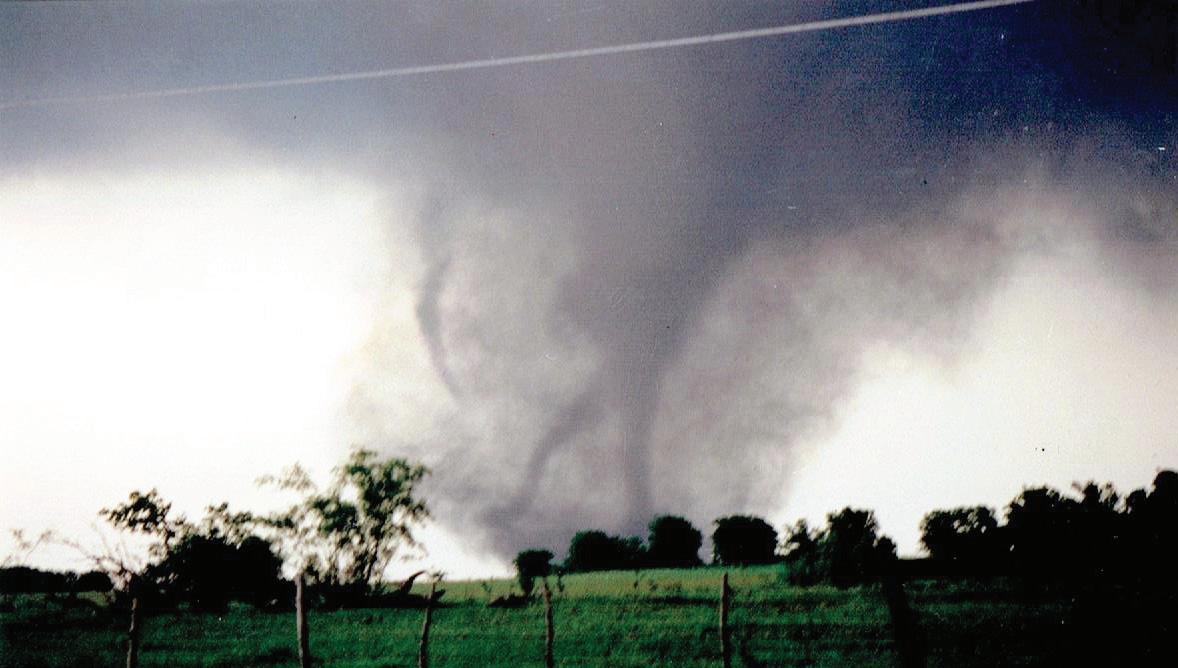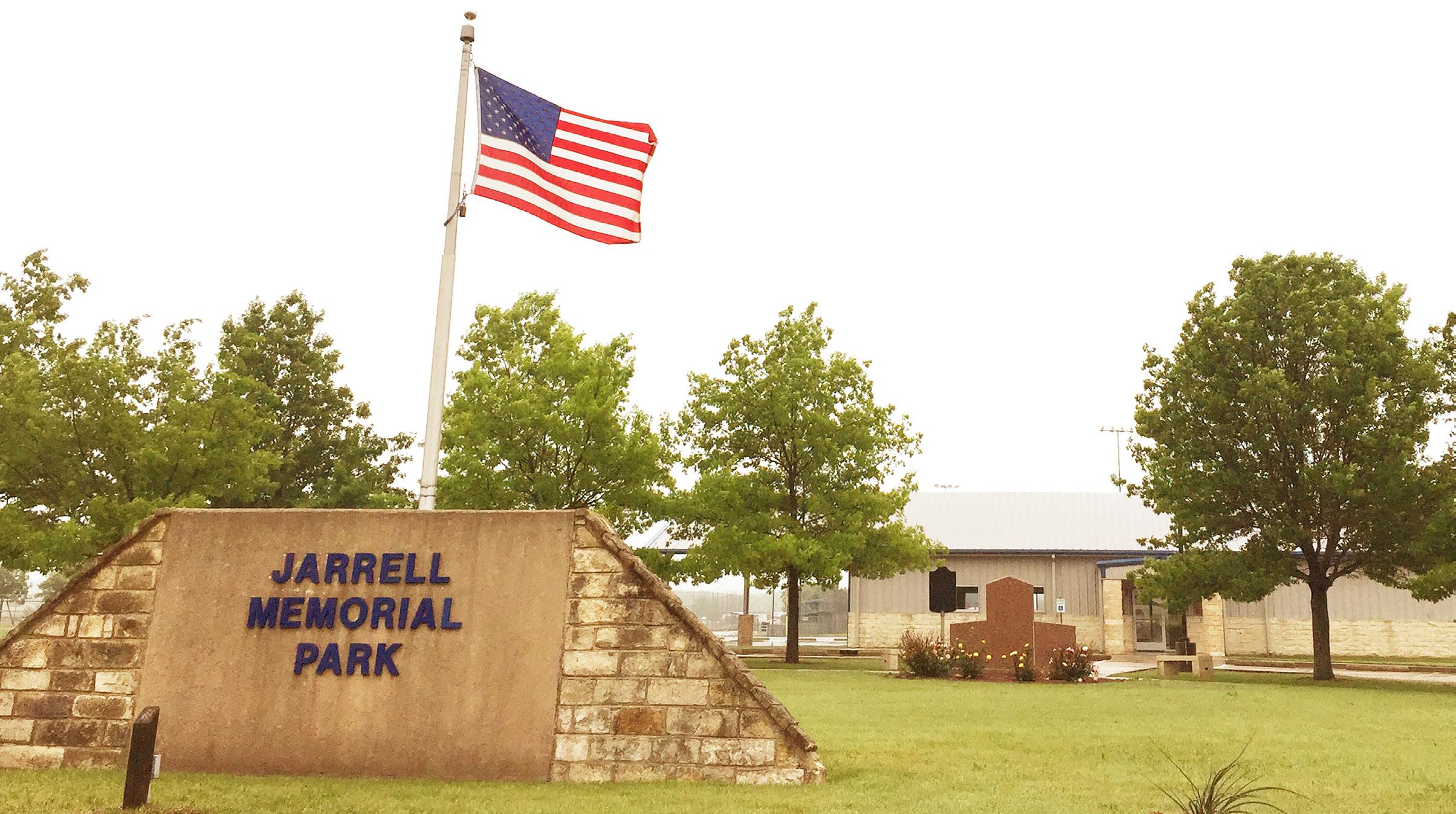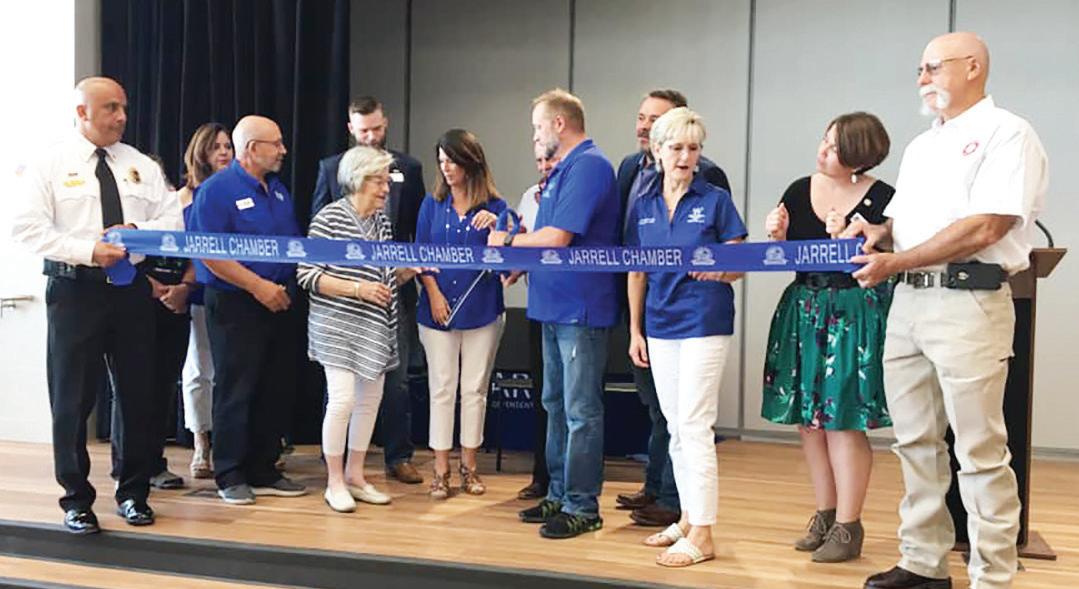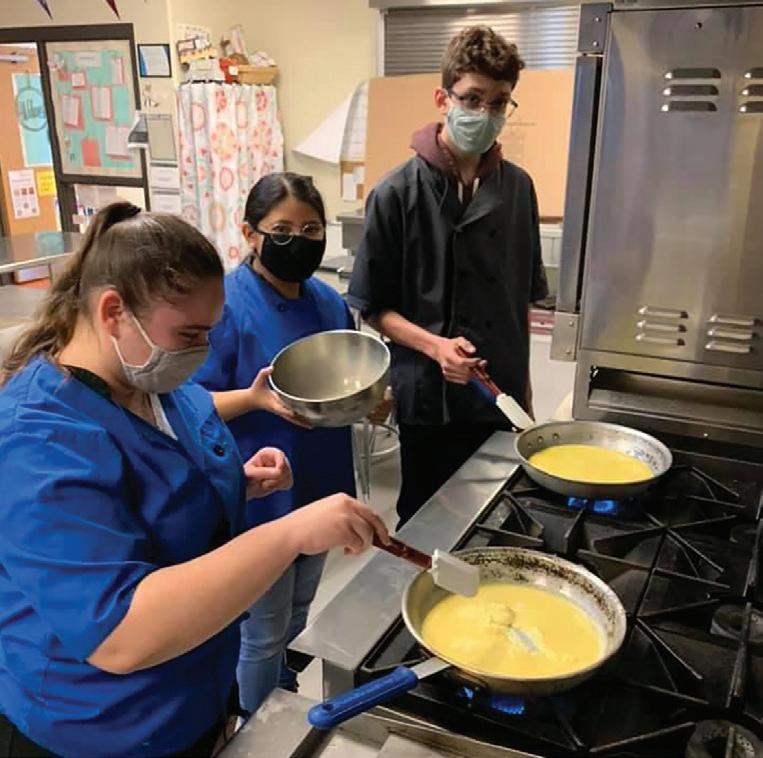
12 minute read
JARRELL REMEMBERS
by Charlotte Kovalchuk • charlotte@myjarrell.com photos by Charlotte Vancil and Scott Beckwith
A Legacy of Love and Strength
Advertisement
Remembering the Tragedy that United the Jarrell Community
Standing on her front porch on May 27, 1997, LaDonna Peterson was struck by how heavy and hot the air felt that morning in Jarrell. “I’ve lived here all my life and it never felt like that,” she says. She recalls telling her husband, "I sure hope it rains to get rid of all this,” as she saw him off to work.
The forecast that day included thunderstorms with heavy rainfall and potential strong winds. Jarrell is no stranger to turbulent weather, with tornados and powerful winds an ongoing chapter in the town’s history. One of the earliest recorded twisters destroyed the Jarrell Methodist Church in 1926, followed by a tornado in 1955 that caused significant damage to buildings. In 1989, an F-3 injured 28 people and killed one. No one in Jarrell, however, was prepared for the one that left all those behind.
OUTBREAK IN CTX
There were 20 tornados in Central Texas that day. Sixty miles north, several—spotted in McLennan and Bell counties—moved south towards Jarrell. At Windy Hill School, just east of I-35 in Jarrell, teacher Priscilla King hunkered down with other staff, nearly 100 preschool children, and some highway drivers. Teachers gathered babies in a portable crib and calmed older kids with games under tables.
As Priscilla watched from a window, a skinny, rope-like tornado spun across the landscape. When it subsided, she and the rest of Jarrell breathed a sigh of relief.
Seconds later, a cloud began forming on the horizon. It reached up to the dark storm wall across the sky as three twisters joined forces in the mass, spawning an F-5 tornado— the rarest, strongest type of tornado. At 4pm, starting at the corner of County Roads 305 and 307, the storm grew almost a half-mile wide with winds more than 260 miles an hour. It whipped through farms and pastures, grinding up everything in its path—homes, barns, windmills, crops, and trees.
From her home on First Street, Charlotte Vancil stood mesmerized by the dark tower churning west in the distance. “You couldn’t take your eyes off it,” she says. “You were just in awe.” She got her camera to capture the scene. A few miles away, Virginia Davidson was doing the same thing, until she realized the tornado was headed straight towards her.
VIRGINIA'S MIRACLE
Virginia was mowing her lawn when she spotted a skinny rope trailing down from the sky in the distance. She started snapping pictures, certain no one would believe she’d seen a tornado and that it would disappear soon. But the rope got bigger.
Forget the pictures, she thought, and ran inside her house. As she huddled in the bathtub with a blanket, she remembered some paychecks she had left on the porch. Grabbing the checks, she shoved them in her purse and slipped it under her body in the bathtub. With the blanket over her head, she waited, scared to death and wondering, Why can’t they stop it?
The first thing she heard was a pop as her front porch light shattered. The whole house started shaking, and she thought the ceiling would crush her. Suddenly, everything went dark and she couldn’t see her hand in front of her face for what seemed like forever. Am I going to know I’m dead or will I just be gone? she wondered.
She felt her house being lifted and moved downhill. Then everything stopped. Oh, I’m still alive. I’m OK, she thought right before the world
around her was destroyed. At first, she couldn’t see anything, then as she heard objects flying, she didn’t want to. She shut her eyes. “I knew I was going to get hit. I didn’t want to see something big coming,” she says.
As wind roared around her, she struggled to cover her face, thinking, if I live through this, I don’t want to be blind. She kept a death grip on her blanket the whole time and screamed at the storm, “You’re not taking my blanket. It’s all I have left!”
Finally, the wind began dying down as the tornado spent its remaining fury on a forest of oak trees along County Road 305 toward Cedar Park.
SURVIVAL MODE
Virginia lay on a pile of debris. Standing up, she saw blood running down her leg. Great, now I’m going to bleed to death, she thought. It began raining and hailing and she realized hail would probably kill her instead. She looked for a place to take shelter and saw her house was a pile of rubble. Where do I go? she wondered. Seeing a partially intact workshop room in her garage, she crawled into it.
When the hail stopped, Virginia emerged from her hiding place wet, bleeding, freezing, shaking, and in shock. She searched the debris and found a jacket to cover herself as rain continued pouring down. She saw her kitchen curtains and wrapped the dirty cloth around her bleeding leg.
Fortified as well as she could be, she went to check on her next-door neighbors; a couple and their two boys. Their house was gone and she later learned they had all been killed. Returning to what was left of her house, she saw police cars with flashing lights lined up along County Road 305. Some men were walking down the road toward her, one with a large pipe wrench that made Virginia think yet again that death was imminent. It turned out he was using it to turn off people’s water meters if their pipes had burst in the storm.
The group directed her to a nearby house still standing, where a woman bandaged her up and let her use the phone. Virginia couldn’t reach her husband and tried her mom. The moment she heard her mom’s voice asking if she was all right, Virginia burst into tears. “I’m OK, but the house is all gone!” she said.
“It’s OK, you’re still alive,” her mother said.
“But the house is all gone!” Virginia repeated.
Meanwhile, her husband was on his way back to Jarrell after hearing about the tornado while at work in Austin. With the road to his house sealed off by law enforcement, he walked across fields in search of his wife, certain she was dead. He found her walking down County Road 305 with burrs in her hair, “looking like a bag lady.”
Together they walked into town to find help. A woman came across the couple and gave them a ride to Georgetown Hospital. When a doctor saw bleeding, black-andpurple Virginia, he asked, “What hit you?”
“What didn’t hit me? My whole house hit me!” she said, still wondering to this day how she survived. “There were refrigerators, cars going through the air. Anything could have killed me. For some reason, I’m still here.”

PROVIDENCE
As the dust settled from the storm, other residents who were spared breathed prayers of gratitude. “God was with us,” Priscilla said after the tornado came within a quarter mile of Windy Hill School and veered west just before reaching the school. "It went five miles to about where Ronald Reagan meets I-35, turned west and went toward Cedar Park where it continued to do extensive damage."
If there was any doubt about the strength of the winds, Wayne Cavalier recalled a news report about a truck from Jarrell found in a yard in Leander. "The tornado didn't go there, but the force of the wind flung the vehicle that far."
...The Jarrell Community Unites
Diane Johns, whose house sat on the edge of the tornado’s path, was working in Austin when the storm hit. When she returned to Jarrell, she lost track of how many times people saw her and exclaimed, “Oh my God, you’re alive!” She finally made it home, thankful to find it standing; her parents and two daughters safe.
Like Virginia and LaDonna, many residents lost everything and were grateful just to be alive. LaDonna was working on her computer while her 7-year-old son played nearby when her mother-in-law called, urging her to take shelter at her house. Even as LaDonna was used to hearing tornado warnings, for some reason she decided to go. “If I hadn’t left that day, my son and I, neither of us would be here,” she says. After the tornado, she and her family members climbed out of the bathroom window to find all but that room destroyed.
She couldn’t believe her eyes as she stared across the barren landscape. Her house and every house in the nearby Double Creek Estates subdivision were gone, and 27 people, including two entire families, had just lost their lives.
DEVASTATION
Evelyn McLean had been an officer with the Georgetown Police Department only a few months when she and other officers were called to help with disaster response in Jarrell. They had been told what to expect and to check bathtubs for tornado survivors. But when they arrived at the scene, there was nothing left to look through. “It was horrific,” Evelyn says. “What we saw was like a war zone.”
What had been the Double Creek neighborhood was now a field of mud. Around 40 houses were gone. As resident Janet Hage drove down County Road 305, she saw asphalt ripped from the road, bark stripped from trees, a dump truck flipped over in someone’s yard, a red T-shirt pulled over a tree.
“It was like a bomb went off,” says Clifford Tschoerner, then assistant fire chief for the Jarrell Volunteer Fire Department. “You always see stuff like that on TV, in other places. You never figure it will happen in your own backyard.” Surrounding agencies joined the response team, including the Texas Department of Public Safety and the Williamson County Sheriff’s Office and EMS. Wearing rubber boots provided by volunteers, responders trudged through the mud, sorting through what little remained from the tornado. It took Clifford and other fire department volunteers two weeks to clean up debris.
COMMUNITY COMES TOGETHER
Thirteen funerals in one day, five caskets from one family—“it ripped your heart out,” Charlotte says. She and everyone else in the small town knew each one of the 27 victims.
“Twenty-seven people may not sound like a lot compared to other cities who have lost more lives, but each one of those were our friends,” Priscilla says. “They were people you might have had dinner with, or gone to church with, or had children go to the same school with.”
Commonly used for school events and town meetings, the Jarrell School cafeteria became a haven after the tragedy. Volunteers mobilized, cooking meals for displaced residents and setting up the school gym for donations that poured in from people all over who were touched by the story of Jarrell’s

tragedy. “Everyone came together and helped each other. I thought that was so great,” Virginia says.
She and LaDonna stayed in donated mobile homes until their houses were rebuilt by a nonprofit group. Almost all the homes destroyed by the tornado were rebuilt thanks to volunteers from Christian Aid Ministries and Habitat for Humanity. To add to the generosity, Georgetown Hospital, now St. David’s Georgetown, canceled every medical bill owed by Jarrell residents, and the Jarrell Recovery Fund ultimately reached $1.7 million. “The goodness of people was amazing,” says Diane, who led the Jarrell Recovery Board. “So many people from outside came and touched our lives and made us stronger.”
LaDonna was encouraged by the outpouring of support during a time when she felt like she couldn’t meet her son’s needs. “In a 7-year-old’s mind, that’s their world—their room and toys,” she says. “He felt like he lost everything that day. I couldn’t even give him a toothbrush at that point. It was a very rough feeling, to feel inadequate.”
After hearing one of LaDonna’s interviews on the news, a California teacher sent her a quilt signed by her students that LaDonna still sleeps with every night. And both she and Janet will never forget when Fiesta Texas hosted Family Day at the Jarrell football field to lift up the community after the tornado. “It brought laughter to kids’ faces and took the fear out of parents’ hearts,” Janet says.
Beauty from Ashes
“I don’t want to say time heals everything, but it makes it easier,” Priscilla says. On the five-year anniversary of the tragedy, the community gathered not only to grieve and remember their losses, but also to encourage each other and see how far they had come. Jarrell was always known for its kindness, but after being overwhelmed by generosity from neighbors and strangers in the tornado’s aftermath, that character became even more deeply ingrained in the fabric of the community. “How can we help?” is now a frequently asked question whenever a neighbor is facing a hard time.
Years after the tornado, when an ice storm froze over I-35 and left drivers stranded, the men of Jarrell used their four-wheel drive vehicles to rescue people and bring them to the Jarrell School gym. The women of Jarrell made a huge pot of Friendship Soup out of anything they had; “The best damn soup I’ve ever had,” Diane recalls, for the dozens of people who spent the night at the gym.
More than 20 years later, Jarrell still remembers the 1997 tornado and its devastating impact. Igo Elementary School, flourishing in its second year, is named after the Igo family who died in the storm. Jarrell Memorial Park was built on the land that used to belong to Larry and Joan Igo, featuring a community center, playground, and Little League ball fields. “A tragic field where families lost their lives became a community support area. Families come together, we play ball, we picnic,” Janet says. “It became like a heartbeat of Jarrell in the aftermath.”
Looking back on the tornado, Priscilla remembers driving down County Road 305 after the storm and seeing the oak trees by Salado Creek that had been reduced to half their size. In their place stood wooden skeletons with barren limbs reaching up to a gray sky. Over the next 20 years, she watched the trees slowly come back to life, anchored by the same deep roots that empowered Jarrell’s resurrection as a community with an even bigger heart as well as a backbone. Today, it’s home to people connected and strengthened by tragedy, people known for their kindness and resilience during hardships.
“Yes, that tornado was horrific, yes it impacted us in so many ways, but we had to learn it did not define us,” Priscilla says. “That is not who we were or who we are. We are a community that has learned the importance of human life, learned the importance of supporting each other, being able to meet each other’s needs, and knowing that when it’s really dark, the sunshine can just be right around the corner.”







